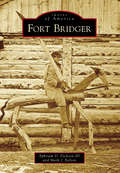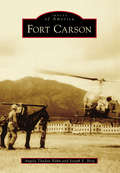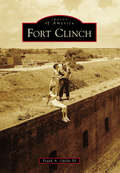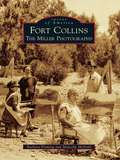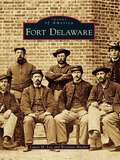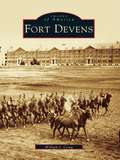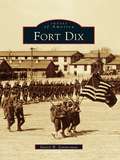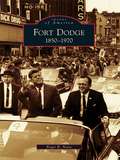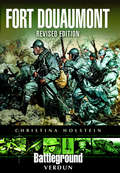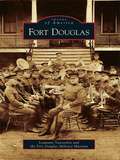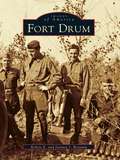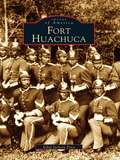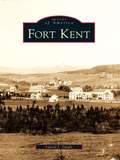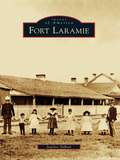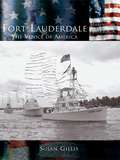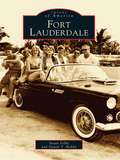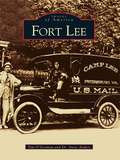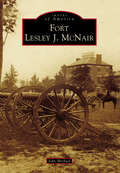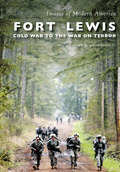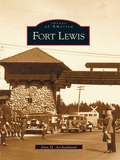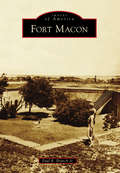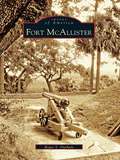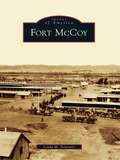- Table View
- List View
Fort Bridger (Images of America)
by Ephriam D. Dickson III Mark J. NelsonThe history of Fort Bridger represents a microcosm of the development of the American West. Situated in an area initially inhabited by the Shoshone people, Fort Bridger was established during a transitional phase between the fur-trade era and the period of western migration. The fort became one of the most important supply points along the nation's western trail network. Later, the post served as a bastion of civilization as one of a number of western military posts. Soldiers at the fort protected not only the lives and property of its local citizenry but also the emerging transportation and communication advancements of a nation. Following the Army's departure, a small settlement emerged at Fort Bridger, using buildings and materials from the old military garrison. Today, the fort and town remain active, in part as a respite for travelers just as it had been more than 150 years ago.
Fort Campbell in Vintage Postcards (Postcard History Series)
by Billyfrank MorrisonSince its establishment in 1941, Fort Campbell, Kentucky, has grown to approximately 30,000 soldiers on over 100,000 acres. With its Southern culture, the base has a rich and interesting history. German prisoners of war were held here during World War II, and Campbell Army Air Field has always been a favorite stopover of NASA shuttle crews. Fort Campbell units have inspired numerous movies and books, such as Black Hawk Down, Band of Brothers, and ShadowWarriors. Through over 200 vintage postcards and photographs, this pictorial history tells the unique story of an army base and its brave soldiers who have fought to defend our country.
Fort Carson (Images of America)
by Angela Thaden Hahn Joseph E. BergArmy scout Kit Carson rode the Southwest in many capacities. He served and retired in Colorado, and so Fort Carson is appropriately named. On land once traversed by Lt. Zebulon Pike, Camp Carson was constructed almost overnight under the watchful eye of Pres. Franklin Roosevelt and with the approval of the neighbors in Colorado Springs. Since its creation, the post has been the home and training grounds for thousands of soldiers who have fought in all wars from World War II to the current war on terror. Fort Carson continues to be a valuable asset to the community economically and in its generosity with resources when a local need arises.
Fort Clinch (Images of America)
by Frank A. Ofeldt IIIAs part of the third system of fortifications built for harbor defense, Fort Clinch was constructed from 1847 to 1867. Serving in three wars, the Civil War, Spanish-American War, and World War II, the fort never saw battle and was never fully completed. Offered for public sale in 1926, Fort Clinch was sold by its owners to the State of Florida in 1935 and became one of the first nine Florida state parks. The fort was partially restored by the Civilian Conservation Corps from 1937 to 1942. Later, the Florida Park Service performed a more comprehensive restoration from 1963 to 1971 and created one of the finest living history programs in the country, offering an interpretation of Fort Clinch as it was in 1864, when the federal army occupied the fort and Amelia Island. Today, Fort Clinch State Park offers a wide range of recreation resources to visitors.
Fort Collins: The Miller Photographs
by Barbara Fleming Malcolm McneillPhotographer Mark Miller opened his studio in Fort Collins, Colorado, in 1914. The town he chose to live and work in sits in a river valley in northern Colorado, nestled between the Rocky Mountain foothills and the semiarid high plains, with Denver to the south and Cheyenne, Wyoming, to the north. Established as a Civil War-era army post, the town was a Wild West frontier outpost until it was tamed in the 1870s by the arrival of a land-grant college and the railroad. By the turn of the century, Fort Collins had become a quietly respectable college town with a thriving economy and steadily increasing population. Over almost six decades, as the small town evolved into a city, Miller photographed people, businesses, and landscapes. Fort Collins: The Miller Photographs offers a representative sampling of the over 70,000 Miller images, a collection housed at the Fort Collins Museum's Local History Archive.
Fort Delaware (Images of America)
by Brendan Mackie Laura M. LeeLocated on Pea Patch Island, Fort Delaware was erected to defend local ports from enemy attack but never received or fired a shot in anger. The first earthen-work version, constructed during the War of 1812, was followed by a second 1820s plan incorporating a masonry star design with a network of drainage ditches. Engineering issues and a low-lying site doomed the structure; in 1831, it was irreparably damaged by fire. A new plan created a more substantial fortification still standing to this day. Fort Delaware evolved into a well-established community that transformed from protector to notorious Civil War prison camp. Most widely known as a prison, it subsequently served in lesser roles through three more conflicts. Images of America: Fort Delaware unifies an amazing pictorial record of Fort Delaware's historical timeline. The story is not only of active duty but its rescue from abandonment and subsequent successful preservation work.
Fort Devens (Images of America)
by William J. CraigThe geographical location of Fort Devens has a military history that dates back to the 1600s, when the area was first garrisoned by British troops. In 1915, the region was again chosen for a cantonment, one of only sixteen in the country. In order to build the camp, the War Department assembled the largest labor force in history. New buildings sprang up at the rate of about ten per day and supported more than one hundred thousand troops that were processed at Camp Devens, as it was originally named, during World War I.Fort Devens is the first book to trace the military activity in this area. Throughout the twentieth century, troops were trained and deployed from Fort Devens for every major conflict the United States was involved in. During World War II, Fort Devens inducted more than six hundred thousand men into the army from the New England area. The list of individuals who have served here included Pulitzer Prize-winning cartoonist Bill Mauldin, Secretary of State Colin L. Powell, and Senator Edward M. Kennedy. Even NASA can trace its birth to Fort Devens by way of Dr. Robert Goddard's liquid-fueled rocket experiments.
Fort Dix (Images of America)
by Daniel W. ZimmermanLocated in central New Jersey, Fort Dix has been training soldiers since its founding in 1917. More than three million men and women have passed through its gates since it was built as one of the original sixteen army camps to train and mobilize soldiers for World War I. Using historical images, Fort Dix chronicles the history of life in an army camp from 1917 to the present. The fort, once known as Camp Dix, has experienced many changes over the years. This unprecedented photographic history traces the evolution from a wooden cantonment to the installation of brick and fiber optics, from a horse-dominated transportation system to a motor vehicle system, and from training recruits to serving Army Reserve and National Guard soldiers. Along the way, Fort Dix depicts the influence of the 78th Division, the Civilian Conservation Corps, the Women's Army Corps, Desert Storm, and the humanitarian work of resettling the Kosovo refugees.
Fort Dodge: 1850 to 1970
by Roger B. NatteFort Dodge was founded in 1850 as a military post to police the Iowa frontier. A subsequent land boom created fortunes that were reinvested in the local economy. The town soon earned the nickname "Mineral City" because of the extensive deposits of coal, gypsum, limestone, and clay. By 1900, the city was a rail center and the world's largest producer of gypsum products. With a highly diversified economy, the city prospered and by World War I was able to claim to have more skyscrapers per capita than any other city in the Midwest and beautiful public buildings designed by some of the nation's leading architects. Between 1900 and 1925, Fort Dodge enjoyed the role as an important political center and the home of two U.S. senators, the director of the U.S. Mint, the solicitor of the Department of the Treasury, a judge on the U.S. Court of Appeals, Eighth Circuit, and the first presidential press secretary and speechwriter. Sons and daughters of the community went on to establish national reputations in art, music, literature, science, and journalism. Images used in this volume come primarily from the archives of the Webster County Historical Society and were chosen to represent the changing character of the community from 1850 to 1970.
Fort Douaumont: Revised Edition (Battleground Verdun)
by Christina HolsteinA WWI guide &“rich in personal experiences from French and German sources . . . a vivid, yet sometimes ghastly, account of the fighting for the fort&” (Burton Mail). The Battle of Verdun, which lasted from 21 February to 15 December 1916, was a turning point in the First World War, and Fort Douaumont was at the heart of it. In 1914 the fort was the strongest and most modern of the fortifications around Verdun and it formed the keystone of the French defense in the area. Using both French and German sources, Christina Holstein introduces the reader to the fortress system around Verdun, explains the construction, reinforcement and armament of Fort Douaumont and describes its surprise capture by the Germans in February 1916. Its loss was a terrible blow to French morale and their repeated attempts to retake the fort are portrayed in graphic detail. As the months ground on and the Battle of Verdun turned into stalemate, the desire to keep or to recapture Fort Douaumont, whatever the cost, became the reason for both sides to go on fighting. Now fully up-to-date, this guide gives a compelling insight into the brutal nature of the struggle and into the soldiers who took part in it and will be essential reading for students of the Battle of Verdun, for visitors to the battlefield, and for anyone who is interested in the history of twentieth-century fortifications. &“Much more than a battlefield guide . . . The plans and campaign maps are clear and easy to follow, and the text is accompanied by some excellent photographs.&”—Fortress Study Group
Fort Douglas (Images of America)
by Louwane Vansoolen Fort Douglas Military MuseumOn October 26, 1862, Col. Edward P. Connor and the 3rd California Volunteers set up Camp Douglas for the purpose of protecting the overland mail and telegraph routes between Nevada and Wyoming. This began a long history of a U.S. military presence in the Salt Lake Valley Mormon community. Although the camp closed on October 26, 1991, the U.S. military still has a presence today on the east bench of Salt Lake City known as Fort Douglas. The base as it was during its heyday of the 38th Infantry is gone, but the parade ground and Gothic sandstone homes of Officers Circle, shaded by trees planted long ago, still remain at Fort Douglas. The horses have disappeared and the "old soldiers have faded away," but the stable and red-brick barracks also remain. A few old-timers still enjoy a stroll around the parade ground, listening for the canyon breeze ruffling through the trees that echo faintly the calls of yesteryear.
Fort Drum (Images of America)
by Robert E. Brennan Jeannie I. BrennanNorthern New York State has boasted a prominent military presence since the War of 1812. Beginning in 1816 with the establishment of Fort Drum's predecessor, Madison Barracks, troops have trained there throughout the summer months and the harsh winters. Today, Fort Drum is the largest military facility in the northeastern United States, home to the 10th Mountain Division, a tactical unit deployed on missions around the world. Beginning with the history of Madison Barracks, Fort Drum depicts its birth as Pine Plains, a ten-thousand-acre training area, and its continued evolution into a military asset. By 1908, soldiers from Madison Barracks began summer maneuvers at Pine Plains under the command of Brig. Gen. Frederick Dent Grant, son of Gen. Ulysses S. Grant. Historic images in Fort Drum show these training camps and what are known today as the greatest military maneuvers in peacetime history during 1935. Today, Fort Drum supports the training of almost eighty thousand troops annually. This striking volume presents the military history of Fort Drum and the missions it continues to support in defense of the United States.
Fort Huachuca (Images of America)
by Ethel Jackson PriceAt the foot of the Huachuca Mountains, the U.S. Army founded one of the most crucial military posts for American expansion into the southwest frontier. Soldiers had been stationed in the region for decades, but in 1877 Fort Huachuca became the symbolic cornerstone of America's western domain. The Native American word huachuca, meaning "place of thunder," described the sporadic but marvelous electrical storms in the area, but the skies would not be the only thing booming. During the tumultuous campaigns to resolve American and Indian disputes, the U.S. infantry and famed Buffalo Soldiers faced off with Geronimo and his Apache nation in both tense negotiations and bitter combat. As time marched on, the fort developed into a permanent installation with barracks, modern training grounds, and other facilities to accommodate troop rotations and eventually became the innovative Center for Military Intelligence.
Fort Kent
by Laurel J. DaigleFort Kent is located in northern Maine where the Fish River joins the St. John River. Joseph Nadeau, the first settler in Fort Kent, arrived in 1829. Acadian refugees from eastern Canada developed a farming community along the fertile river valleys, and within a short time other settlers from Canada and lower Maine came to make a new life. Fort Kent, remote from other populated areas, gradually developed into a thriving farming and lumbering community. An early pioneer, Maj. William Dickey was a strong advocate for the region and helped to establish the Madawaska Training School, a public school system, and improve roads. In 1902, the railroad connected to Fort Kent and provided needed freight and passenger services. As a border town, Fort Kent has enjoyed a colorful past, especially during the years of Prohibition, and a rich history that continues today.
Fort Laramie
by Starley TalbottFort Laramie was one of the most important frontier outposts of the American West. Founded as the trading post Fort William in 1834, the fort became a U.S. military post in 1849. Beginning in 1841, emigrants stopped at Fort Laramie while traveling the Oregon, California, and Mormon Trails. Fort Laramie served as a gathering place for thousands of Native Americans and hosted the 1851 and 1868 treaty councils. When the treaties failed, the post became the staging area for campaigns that eventually led to the tribes's confinement on reservations. Fort Laramie was abandoned by the military in 1890; the buildings were auctioned and served private interests during the homestead period from 1890 to 1937. Fort Laramie was acquired by the state of Wyoming in 1937, and the fort became a unit of the National Park System in 1938. Fort Laramie National Historic Site is open daily except New Year's Day, Thanksgiving, and Christmas. The restoration of many structures to their historical appearance provides visitors with a glimpse of the past.
Fort Lauderdale: The Venice of America
by Susan GillisTaking its name from a fortification established more than 160 years ago during the Second Seminole War, Fort Lauderdale boasts a history stretching back 5,000 years before the first white settlers arrived in the eighteenth century. From beautiful tales of the "mysterious" New River that helped launch the community to more recent stories of rum running and gambling, segregation and integration, and boom and bust, the history of this Florida city is told here through the everyday lives of those who lived it.
Fort Lauderdale
by Susan Gillis Daniel T. HobbyLike many Sun Belt cities, Fort Lauderdale has experienced phenomenal growth over the past several decades. Once a wilderness home for the Seminole Indians and a few hardy pioneers, the small community grew up around Frank Stranahan's successful trading post, a convenient stop for hunters, fishermen, and sightseers preparing to head into the Everglades. But much more was in store for this rugged outback camp. Surveying Fort Lauderdale's fascinating history chronologically, this pictorial retrospective begins with the 1890s, a time when this part of the country was still part of America's frontier, isolated and wild. With the coming of the railroad and the twentieth century, an agricultural economy developed, and, soon, the Florida land boom would bring thousands of new settlers to the area. Fort Lauderdale's glistening beaches and comfortable climate earned the city anearly reputation as a tourist town and, eventually, as a Spring Break mecca.
Fort Lauderdale: Playground of the Stars
by Ed Mcmahon Jack DruryFew Southern cities have stronger claims to fame than Fort Lauderdale. As one of the great vacation destinations in America, over the years it attracted such celebrities as Bob Hope, Jayne Mansfield, Johnny Carson, Cary Grant, and the worldchampion New York Yankees. This beach townâ TMs history is starstudded and rich with interesting stories and photographs from that period.
Fort Lee (Images of America)
by Tim O’gorman Dr Steve AndersFort Lee, located adjacent to the Petersburg Civil War Battlefield, is the designated Home of the United States Army Quartermaster Corps. The first Camp Lee, established as a National Army Cantonment in 1917, trained the 80th Division for service in France. In 1940, Camp Lee was reestablished, and since World War II, has trained hundreds of thousands of Quartermasters, whose numerous skills include military supply, water and petroleum operations, Army field feeding, and parachute rigging for "supply by sky." Fort Lee is also the home of the Defense Commissary Agency and the Army Logistics Management College, which provides advanced schooling for Armed Forces logisticians. For over 60 years, Fort Lee has played a vital role ensuring that America's Army is the best-equipped and most well-supported army in the world.
Fort Lesley J. McNair (Images of America)
by John MichaelFrom southeast Washington, DC, where the Potomac and Anacostia Rivers meet, this fort has continued to protect America's capital. In 1791, Pierre L'Enfant designated it as a military reservation. The post is the third oldest in continuous operation--as an arsenal, a penitentiary, a hospital, and now, a military education center. It was renamed in 1948 to honor Lt. Gen. Lesley J. McNair, who was killed in World War II. Over the course of two centuries, the fort has born witness to the British ransacking during the War of 1812; a Civil War explosion that killed female arsenal workers; and the incarceration, trial, and hanging of Lincoln assassination conspirators. Over time, it became the home of several artillery commands, the first federal penitentiary, the US Army Engineer School, the US Army Music School, the US Army War College, and the US Army Band ("Pershing's Own"). Today, it has evolved into the National Defense University, Inter-American Defense College, and the headquarters of the Military District of Washington.
Fort Lewis: Cold War to the War on Terror (Images of Modern America)
by Alan H. ArchambaultCamp Lewis was established in 1917 as a training camp for the US Army in World War I. Made a permanent post in 1927, Fort Lewis became an important base for training and sending soldiers to combat in World War II and the Korean War. In 1956, the 4th Infantry Division arrived at Fort Lewis while America was deeply committed to protecting democracy around the world during the Cold War. From that time forward, Fort Lewis has been in the forefront of military reservations in the United States. The post played a crucial role in the Vietnam War, Operations Desert Shield and Desert Storm, and the War on Terror. Soldiers based at Fort Lewis have deployed to conflicts throughout the world in defense of freedom. Today, Fort Lewis remains on the cutting edge of America's sword.
Fort Lewis: Cold War To The War On Terror (Images of America)
by Alan H. ArchambaultThe area now known as Fort Lewis was first recognized for its potential as a military reservation in the early 1900s when a series of militia and national guard encampments were held in the area. Camp Lewis was established as the United States entered World War I in 1917 and became the first Army installation in the history of the nation to be created as a direct result of the outright gift of land by private citizens. During World War I, Camp Lewis became the largest military post of the era. Here, thousands of "doughboys" trained for the Great War and began a tradition of training excellence that continues to this day. In 1927, the camp was designated a permanent post and offically became Fort Lewis.The story of this important military installation is told here in a series of historic photographs, from the collections of Fort Lewis Military Museum dating from the early 20th century to the present. The photographs capture not only the natural beauty of the area and prominent buildings, but also many of the men and women who have served their nation at Fort Lewis.
Fort Macon
by Paul R. BranchSilently standing guard on the eastern point of Bogue Banks overlooking the entrance to Beaufort Harbor, Fort Macon is the centerpiece of one of the most visited North Carolina State Parks. Since Fort Macon State Park was established in 1924, it has been a familiar destination for millions of visitors to the "Crystal Coast" of Carteret County, North Carolina. The old historic fort itself, standing today in venerable repose, harkens back to another time in our country's history, however. At different times throughout its long, storied past, the fort has served as a US Army garrison post, a stronghold occupied for defense in three different wars, the scene of a desperate battle, a prison, and finally the second oldest state park in North Carolina. Fort Macon showcases this unique coastal fortification through historic images, highlighting not only its military past, but its role as a popular tourism destination through the years.
Fort McAllister: Fort Mcallister, Georgia, In The Civil War And Beyond (Images of America)
by Roger S. DurhamMany earthen fortifications defended the city of Savannah and its numerous water approaches after the Civil War broke out. One of these defenses, Fort McAllister, protected the entrance to the Ogeechee River and the strategic railroad and highway bridges upstream. From November 1862 to March 1863 the U.S. Navy bombarded the fort seven different times without success. The fort finally fell to General Sherman in December 1864; ironically, the final threat the fort faced was not from an enemy trying to get up the river, but from one trying to get down the river to the sea. In the 1920s auto magnate Henry Ford renovated the fort and focused new attention on its history.
Fort McCoy (Images of America)
by Linda M. FournierFrom the days of the horse-drawn caisson to today's Humvee, Fort McCoy has played a vital role in the military readiness of America's armed forces. The only federal military installation within the state of Wisconsin, Fort McCoy has seen more than five million military personnel from throughout the UnitedStates pass through its gates since its founding in 1909. Fort McCoy exists today primarily because its founder, Maj. Gen. Robert B. McCoy, foresaw that the U.S. Army would need a regional site at which to train and maneuver and then dedicated himself to making that vision a reality. Fort McCoy's mission ofsupporting training and mobilization has remained constant from those early days on the McCoy ranch to the current global War on Terror. This book chronicles the illustrious history of Fort McCoy from the doughboys of World War I to today's soldiers supporting Operations Enduring Freedom and Iraqi Freedom.
